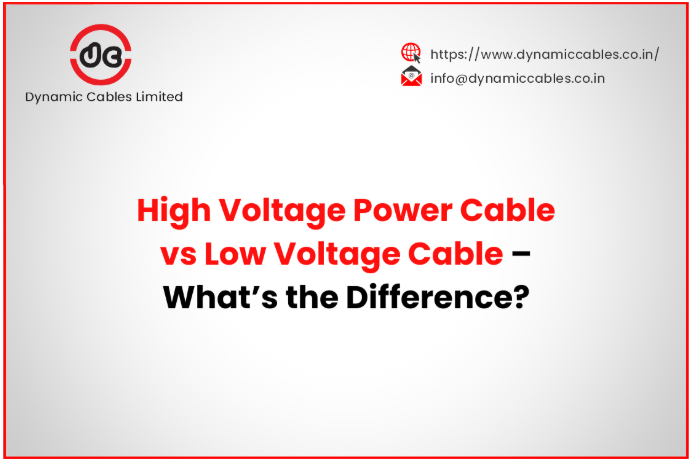- An ISO 9001:2015, 14001:2015 & 45001:2018 Company

High Voltage Power Cable vs Low Voltage Cable. What’s the Difference?
Selecting the ideal cable for any electrical system is crucial for safety, efficiency and long-term reliability. Project decisions usually center around High Voltage Power Cable vs Low Voltage Cable debates - each type serves distinct purposes in specific loads, distances or environmental conditions. Understanding the differences helps engineers, builders, and homeowners make the right choice.
What is a High Voltage Power Cable?
A high voltage power cable is designed to transmit electricity above 1100 volts. These cables are the backbone of large-scale infrastructure, carrying bulk power from generation plants to substations and industrial facilities.
Key Features of High Voltage Cables:
- Long Service Life: With proper installation and maintenance, high voltage cables with advanced insulation such as XLPE may last over 30 years with regular use.
- High Current Capacity: They transmit electricity efficiently over long distances, minimizing energy loss.
- Flexibility in Installation: Modern designs make installing them simpler in even challenging environments.
- Durability: Resistant to moisture, chemicals, heat, and mechanical stress, making them reliable in tough conditions.
These features make them highly suitable for industries, utilities, and large-scale power transmission projects.
What is a Low Voltage Cable?
On the other side of the High Voltage Power Cable vs Low Voltage Cable comparison, low voltage cable is designed for systems operating at 1100 volts or below. They are widely used in homes, offices, and small commercial setups.
Examples of Low Voltage Wire Applications:
- Low voltage lighting cable – perfect for residential lighting systems.
- Low voltage single-core aluminium armourd cable – used in local distribution networks.
- Low voltage unarmoured aluminium power cable – suitable for single-phase and three-phase AC systems up to 1100V.
These cables are economical, easier to install, and ideal for daily applications where heavy loads aren’t required.
High Voltage Power Cable vs Low Voltage Cable – Core Differences
| Aspect | High Voltage Cables | Low Voltage Cable |
|---|---|---|
| Voltage Range | Above 1100V | Up to 1100V |
| Application | Power plants, substations, industrial grids | Homes, offices, local distribution |
| Materials | XLPE insulation, Aluminium / Copper conductor | XLPE / PVC, Aluminium/Copper conductors |
| Cost | Higher due to durability and insulation | More affordable |
| Service Life | 30+ years with maintenance | Shorter lifespan compared to HV cables |
Benefits of High Voltage Cables
One of the main advantages of High Voltage Power Cable over Low Voltage Cable is their efficiency.
- Efficient Power Transmission: Transport electricity over long distances with minimal losses.
- Increased Transmission Capacity: Handles larger loads without needing extra conductors.
- Durability: Withstands extreme conditions, offering lower replacement costs.
- Flexibility: Can be installed underground, or in cable trays.
- Environmental Resistance: Designed to resist moisture, chemicals, UV rays and temperature extremes.
Choosing Between High Voltage and Low Voltage Cables
The right choice depends on the scale of your project.
- For power-intensive industries and utilities, high voltage power cable is the only solution.
- For households, commercial offices, and small setups, low voltage wire or low voltage lighting cable provides reliable and economical performance.
Ultimately, when comparing High Voltage Power Cable vs Low Voltage Cable, the decision rests on power demand, distance, safety, and cost considerations.
Conclusion
High Voltage Power Cable and Low Voltage Cable differ not only by voltage rating but also in application, durability and efficiency. High voltage is designed for industrial-scale transmission needs while low voltage supports daily residential and commercial needs. At Dynamic Cables Limited, we manufacture both high voltage power cable types and low voltage wire solutions, ensuring quality, safety, and long-term reliability for every application.
Frequently Asked Questions (FAQs)
Q1. What is the main difference between high voltage and low voltage cables?
High voltage cables transmit electricity above 1100V for industrial use, while low voltage cables operate at 1100V or below for homes and offices.
Q2. How long do high voltage cables last?
With proper installation and care, a high voltage power cable can last over 30 years.
Q3. Can I use low voltage cable for industrial applications?
Low voltage is suitable only for small-scale industrial or residential use. Large-scale projects require high voltage cable types.
Q4. What factors affect high voltage cable price?
The high voltage cable price depends on conductor size, insulation material, voltage grade and installation requirements.
Q5. Who are the trusted high voltage cable suppliers?
Companies like Dynamic Cables Limited are recognized high voltage power cable manufacturers offering tested and reliable solutions for industrial and residential needs.
 English
English

 C701, Tower-C, Noida One
C701, Tower-C, Noida One
